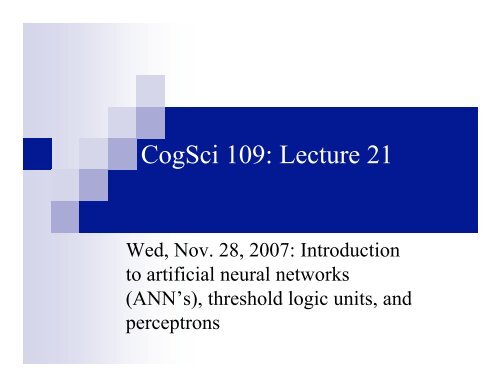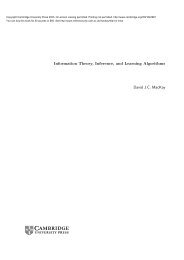Intro to neural networks I - the TLU and perceptrons - MAELabs UCSD
Intro to neural networks I - the TLU and perceptrons - MAELabs UCSD
Intro to neural networks I - the TLU and perceptrons - MAELabs UCSD
You also want an ePaper? Increase the reach of your titles
YUMPU automatically turns print PDFs into web optimized ePapers that Google loves.
CogSci 109: Lecture 21<br />
Wed, Nov. 28, 2007: <strong>Intro</strong>duction<br />
<strong>to</strong> artificial <strong>neural</strong> <strong>networks</strong><br />
(ANN’s), threshold logic units, <strong>and</strong><br />
<strong>perceptrons</strong>
Outline for <strong>to</strong>day<br />
Announcements<br />
Review<br />
Definition <strong>and</strong> overview of artificial <strong>neural</strong> <strong>networks</strong><br />
Motivation<br />
Review of <strong>neural</strong> structures <strong>and</strong> relation <strong>to</strong> ANN’s<br />
The power of many - <strong>the</strong> massively parallel nature of<br />
<strong>neural</strong> network structures<br />
The double-edged sword of ANN’s<br />
Pitfalls<br />
Proper uses<br />
<strong>Intro</strong>duction <strong>to</strong> threshold logic units (T. L. U.)<br />
His<strong>to</strong>rical significance<br />
Logical<br />
<strong>Intro</strong>duction <strong>to</strong> perceptron logic units (P.L.U.)
Announcements<br />
Readings<br />
Hw 6 up later <strong>to</strong>night or <strong>to</strong>morrow<br />
Nick will hold extra office hours in <strong>the</strong> lab Friday<br />
<strong>to</strong> help<br />
Time announced on website
But is <strong>the</strong>re ano<strong>the</strong>r way?<br />
As cognitive scientists you might want <strong>to</strong> create a fit <strong>to</strong><br />
very nonlinear difficult data, <strong>and</strong> <strong>the</strong> methods we have<br />
used may have difficulty<br />
Or model a system whose properties are not simple, or<br />
are difficult <strong>to</strong> define<br />
You may want <strong>to</strong> model cognition <strong>and</strong> performance of<br />
large groups of structure in <strong>the</strong> brain ra<strong>the</strong>r than just<br />
behavior<br />
Gosh I wish <strong>the</strong>re was a model for <strong>the</strong>se sorts of<br />
concepts…
There is! Artificial Neural Networks<br />
(A.N.N.’s)<br />
A study of nature leads <strong>to</strong> a useful model<br />
Something about <strong>the</strong> organization of <strong>the</strong> structures of <strong>the</strong><br />
brain allows us <strong>to</strong> solve complex problems with ease,<br />
adapt <strong>to</strong> new situations, <strong>and</strong> deal with large errors,<br />
incomplete information <strong>and</strong> faults (brain injury)<br />
Artificial Neural Networks are an attempt <strong>to</strong> simulate<br />
by ma<strong>the</strong>matical means an idealized representation of <strong>the</strong><br />
basic elements of <strong>the</strong> brain <strong>and</strong> <strong>the</strong>ir<br />
Functionality<br />
Interconnections<br />
Signal processing<br />
Self-organization capabilities
Brief review of neuronal<br />
structures <strong>and</strong> relation <strong>to</strong> ANNs<br />
A simplified biological neuron Classic threshold logic unit
One neuron alone is not where<br />
<strong>the</strong> true power lies<br />
Electrical impulses travel along <strong>the</strong> axons <strong>and</strong> are<br />
transmitted <strong>to</strong> o<strong>the</strong>r neurons via synaptic connections<br />
If enough incoming pulses arrive in a particular neuron in<br />
a given amount of time, <strong>the</strong> neuron fires, transmitting a<br />
new electrical impulse down its axon<br />
This is a fairly slow process (relative <strong>to</strong> computer<br />
architecture) for a single neuron, but…
Why is a <strong>neural</strong> structure so powerful?<br />
Massively parallel<br />
Parallel vs. serial demo<br />
Very fault <strong>to</strong>lerant<br />
When you for example are writing a program <strong>and</strong> miss a .^<br />
or misspell a variable, that is a fault, brain is less<br />
sensitive <strong>to</strong> that kind of thing since many neurons<br />
contribute <strong>to</strong> <strong>the</strong> same computation
Why is a <strong>neural</strong> structure so powerful<br />
(II)?<br />
Low power consumption<br />
Brain consumes orders of magnitude less energy than any<br />
known digital technology for similar elementary<br />
operations (logic, for example)<br />
10^11 neurons, <strong>and</strong> ~10^15 connections<br />
Plasticity of <strong>the</strong> brain - adaptation of connectivity<br />
patterns which allows us <strong>to</strong> learn<br />
Compare 10^3-10^5 connections of each neuron <strong>to</strong> o<strong>the</strong>rs<br />
with ~10 for a digital logic circuit<br />
Highly interconnected nature
The double-edged sword of<br />
A.N.N.’s<br />
A.N.N.’s solve problems in very different ways from<br />
usual computer programming<br />
No series of precise instructions (program) for <strong>the</strong><br />
machine <strong>to</strong> execute<br />
ANN is more adaptive, self-organizing progressively <strong>to</strong><br />
approximate <strong>the</strong> solution<br />
Frees <strong>the</strong> problem solver from having <strong>to</strong> specify <strong>the</strong> steps <strong>to</strong> a<br />
solution<br />
Also hides <strong>the</strong> steps <strong>to</strong> <strong>the</strong> solution, so you may not learn how a<br />
problem is being solved by a person in an experiment for example,<br />
you can just model it in a way that predicts <strong>the</strong> answer<br />
Example - two volunteers, sentence comprehension
Look not for <strong>the</strong> panacea of<br />
modeling, look for what’s useful<br />
for your purposes<br />
(Panacea - a solution or remedy for all difficulties<br />
or diseases)<br />
So take-home message - as always with modeling,<br />
use <strong>the</strong> ANN model with care, consider <strong>the</strong><br />
application <strong>and</strong> you are likely <strong>to</strong> gain many useful<br />
insights using <strong>the</strong>m<br />
Mouse example
A.N.N.’s are best at…<br />
ANN’s are best at problems where little or nothing is<br />
known, so building a ma<strong>the</strong>matical model is difficult, but<br />
<strong>the</strong>re happens <strong>to</strong> be a great deal of data is available<br />
A.N.N.’s are data-driven<br />
Some common applications of this type are<br />
pattern classification<br />
non-linear function approximation <strong>and</strong> system modeling<br />
Control<br />
associative memory<br />
system prediction
The basics of Artificial Neurons<br />
ANN’s are made of up many repetitions of <strong>the</strong><br />
same simple structure, artificial neurons<br />
1943, McCulloch <strong>and</strong> Pitts wrote a very<br />
influential paper (which you will read) <strong>and</strong><br />
introduced:<br />
The Threshold Logic Unit (<strong>TLU</strong>) also known as a<br />
Linear Threshold Gate
The threshold logic unit (<strong>TLU</strong>)<br />
Takes real-valued inputs (e.g. 0.243 as opposed <strong>to</strong> 1 or 0<br />
only), x i , each input associated with a “weight” w i (or<br />
“synaptic weight”), which represents <strong>the</strong> contact between<br />
two nerve cells<br />
Performs a weighted sum of <strong>the</strong> x’s, <strong>and</strong> if <strong>the</strong> sum is<br />
larger than a threshold (<strong>the</strong>ta), <strong>the</strong> neuron outputs a 1,<br />
o<strong>the</strong>rwise a 0<br />
The neuron will ‘fire’ if <strong>the</strong> threshold is exceeded,<br />
o<strong>the</strong>rwise it does nothing
Artificial Neuron Firing…<br />
Neuron Activation is defined by <strong>the</strong> weighted<br />
sum of<br />
And whe<strong>the</strong>r <strong>the</strong> neuron fires is determined by<br />
€<br />
€<br />
Activation = ∑ wix i = w T x<br />
n<br />
i=1<br />
y(x) = 1 if w ⎧ n<br />
⎪ ∑ ix i ≥ θ,<br />
⎨<br />
i=1<br />
⎩<br />
⎪ 0 o<strong>the</strong>rwise
Perceptrons are more general<br />
than <strong>TLU</strong>’s<br />
So how is this useful?<br />
Since it can output a 0<br />
or 1, a perceptron<br />
alone can perform<br />
many logical<br />
operations<br />
AND, OR, NOT<br />
Demos<br />
Combined with more<br />
than one <strong>TLU</strong>, you can<br />
have continuous<br />
functions, since output<br />
of one can be<br />
weighted input <strong>to</strong><br />
ano<strong>the</strong>r
How does it ‘learn?’<br />
The idea is that <strong>the</strong> perceptron is ‘trained’ by beginning<br />
with a guess for <strong>the</strong> weights, giving it an input, it<br />
generates an output (0 or 1), <strong>the</strong>n that is compared with<br />
<strong>the</strong> desired output, <strong>and</strong> <strong>the</strong> weights are updated according<br />
<strong>to</strong> some rule<br />
i.e. - if it was wrong, change <strong>the</strong> weights so next time it<br />
will be ‘less wrong’<br />
think about our discussions of error criteria<br />
After <strong>the</strong> training period, it should respond <strong>to</strong> certain<br />
inputs with reasonable outputs<br />
Guess what is a popular algorithm for updating <strong>the</strong><br />
weights?<br />
Yep, gradient descent - usually modified <strong>to</strong> be conjugate<br />
gradient <strong>to</strong> help with convergence
Perceptron learning rule<br />
1. Initialize weights <strong>and</strong> threshold r<strong>and</strong>omly<br />
2. Present an input vec<strong>to</strong>r <strong>to</strong> <strong>the</strong> neuron<br />
3. Evaluate <strong>the</strong> output of <strong>the</strong> neuron<br />
4. Evaluate <strong>the</strong> error of <strong>the</strong> neuron <strong>and</strong> update <strong>the</strong> weights<br />
according <strong>to</strong> :<br />
t +1 t<br />
wi = wi + η(d − y)xi<br />
1. Where d is <strong>the</strong> desired output, y is <strong>the</strong> actual output of<br />
<strong>the</strong> neuron, <strong>and</strong><br />
<strong>the</strong> step size<br />
η(0 < η
Computing "<strong>and</strong>":<br />
‘And’ review<br />
There are n inputs, each ei<strong>the</strong>r a 0 or 1. To compute <strong>the</strong> logical<br />
"<strong>and</strong>" of <strong>the</strong>se n inputs, <strong>the</strong> output should be 1 if <strong>and</strong> only if all<br />
<strong>the</strong> inputs are 1. This can easily be achieved by setting <strong>the</strong><br />
threshold of <strong>the</strong> perceptron <strong>to</strong> n. The weights of all edges are 1.<br />
The net input can be n only if all <strong>the</strong> inputs are active.
Computing "or":<br />
‘Or’ revieww<br />
It is also simple <strong>to</strong> see that if <strong>the</strong> threshold is set <strong>to</strong> 1, <strong>the</strong>n <strong>the</strong><br />
output will be 1 if at least one input is active. The perceptron in<br />
this case acts as <strong>the</strong> logical "or".
Computing "not":<br />
‘Not’ review<br />
The logical "not" is a little tricky, but can be done. In this case,<br />
<strong>the</strong>re is only one boolean input. Let <strong>the</strong> weight of <strong>the</strong> edge be -1,<br />
so that <strong>the</strong> input which is ei<strong>the</strong>r 0 or 1 becomes 0 or -1. Set <strong>the</strong><br />
threshold <strong>to</strong> 0. If <strong>the</strong> input is 0, <strong>the</strong> threshold is reached <strong>and</strong> <strong>the</strong><br />
output is 1. If <strong>the</strong> input is -1, <strong>the</strong> threshold is not reached <strong>and</strong> <strong>the</strong><br />
output is 0.
Limitations of a single neuron<br />
XOR problem -<br />
build a perceptron which takes 2 boolean inputs <strong>and</strong> outputs <strong>the</strong> XOR of <strong>the</strong>m.<br />
What we want is a perceptron which will output 1 if <strong>the</strong> two inputs are different<br />
<strong>and</strong> 0 o<strong>the</strong>rwise.<br />
Consider <strong>the</strong> following perceptron as an attempt <strong>to</strong> solve <strong>the</strong> problem<br />
Input<br />
•If <strong>the</strong> inputs are both 0, <strong>the</strong>n net input is 0 which is less than <strong>the</strong> threshold (0.5). So <strong>the</strong> output is 0 - desired<br />
output.<br />
•If one of <strong>the</strong> inputs is 0 <strong>and</strong> <strong>the</strong> o<strong>the</strong>r is 1, <strong>the</strong>n <strong>the</strong> net input is 1. This is above threshold, <strong>and</strong> so <strong>the</strong> output 1 is<br />
obtained.<br />
•But <strong>the</strong> given perceptron fails for <strong>the</strong> last case<br />
0<br />
0<br />
1<br />
1<br />
Input<br />
0<br />
1<br />
0<br />
1<br />
Desired<br />
Output<br />
0<br />
1<br />
1<br />
0
Never fear, we can make more!<br />
That’s why combining more than one makes<br />
<strong>neural</strong> <strong>networks</strong> more general for solving<br />
problems<br />
More details on that next time

















